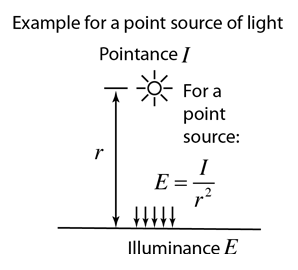Luminous Power Per Unit Area of Surface
(Illuminance)
The power per unit area on an illuminated surface, sometimes called areance, is distinguished from the similar quantity for the source. In radiometry the surface areance may be called irradiance and luminous areance may be called illuminance. This is the quantity of practical importance in judging whether an area is lighted well enough for reading or other activities. The illuminance is measured in lux, but the older unit footcandle is still encountered.
 Examples of common illuminance levels from Wikipedia at right. |  |
| Include surface angle |
Photometry concepts
Vision concepts
| HyperPhysics***** Light and Vision | R Nave |
